|
From 1928 to 1937, the Institute conducted fifteen seasons of excavation of the Yin-hsu site. Eleven large tombs, along with more than 1300 small graves, had been discovered on the highlands of Hsi-pei-kang, located on the northern shore of the Huan River. Whereas in the Hsiao-t’un village on the southern shore of the river, three well structured hang-t’u (pounded earth) construction sites were found.
The Museum separates topics of the Yin-hsu area into the “Shang Royal Cemetery at Hsi-pei-kang” and the “Shang Palace and Ancestral Temples at Hsiao-T’un.” Representative of the Hsi-pei-kang site are royal tombs M1550, M1004, M1400 and sacrificial pits M1022, M1005, M1083 and M1435. On the other hand, tomb 331, horse-and-chariot pits M40 and YH127 are among the remains of Hsiao T’un. The exhibition here aims to provide visitors a glance into the funerary rites, the ritual and warfare were intimately tied to political authority, and the structure of the army in the Shang Dynasty.

|
Niu Fang-ting
Resource Identifier:R001750
Description:This bronze ox cauldron is the largest and heaviest bronze ever found in the archaeological excavations carried out by the Institute at Anyang. It was unearthed at the northern end of the southern corridor of the Royal Tomb M1004, placed together with the bronze deer cauldron. The main decoration on each of the four sides is an ox head in relief. On the two wider sides, there is a standing phoenix on each side of the ox head. On the two narrower sides appear one dragon and one bird on each side of the ox head. There is a band of k'uei-dragon patterns on the upper portion of the vessel. The four legs of the square cauldron are also decorated with ox heads. A pictograph character for niu (ox) is cast on the inner bottom of the vessel.
Date:Late 14th-mid 11th century B.C.
Format:Height 73.3,length64.1,width45.4 cm,weight 110kg
Coverage:Royal Tomb M1004,His-pei-kang,Anyang,Honan. |
| |
|
| |
|
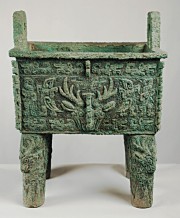
|
Lu Fang-ting (Bronze Square Cauldron with a Deer Emblem)
Resource Identifier:R001751
Description:Unearthed together with the Niu Fan-ting, this cauldron is similar in type, but smaller in size. The main decoration on each of the sides is a deer head with a standing bird on each side. A band of k’uei-dragon patterns appears on the upper and lower parts of the vessel. The inscription cast on the bottom of the vessel is a pictographic character for "deer.
Date:Late 14th-mid 11th century B.C.
Format:Height 60.9, length 51.4, width 37.4 cm, weight 60.4 kg.
Coverage:Royal Tomb M1004, Hsi-pei-kang, Anyang, Honan |
| |
|
| |
|

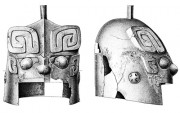
|
Helmet
Resource Identifier:R015337
Description:The excavation of Royal Tomb M1004 yielded a large number of bronze helmets worn by warriors of the Shang. This example is one of the best-preserved pieces among them. The front is decorated with a horned animal mask. The eyes, ears and snout are all raised from the surface. A round boss can be found on both sides, embellished in the center with a whorl pattern. The top has a tubular holder, possibly used to hold decorative feathers.
Date:Late 14th-mid 11th century B.C.
Format:Height 26.5, maximum diameter 23.0 cm.
Coverage:Royal Tomb M1004, Hsi-pei-kang, Anyang, Honan |
| |
|
| |
|
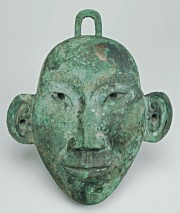

|
Human Mask
Resource Identifier:R001116
Description:This is a realistic human mask with a short, narrow forehead, round chin and wide, flat cheekbones. There is a loop on the top for hanging, and six tubes cast onto the back of the eyes, ears and nose of the mask, indicating that it was not an ordinary mask. Its use is unknown.
Date:Late 14th-mid 11th century B.C.
Format:Height 25.3, width 23.4 cm.
Coverage:Royal Tomb M1400, Hsi -pei-kang, Anyang, Honan |
| |
|
| |
|
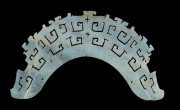
|
Jade Head Ornament
Resource Identifier:R001737
Description:This is an openwork jade carving in the shape of a huang pendant. From the position in which it was found when excavated, it is believed to be a head ornament.
Date:Late 14th-mid 11th century B.C.
Format:Length 20.5, width 6.2 cm.
Coverage:Tomb M2009, Hsi -pei-kang, Anyang, Honan |
| |
|
| |
|

|
Yu Basin with Revolvable Dragons
Resource Identifier:R001089-90
Description:Two almost identical items were found. The basin is shaped like a kuei bowl with flared mouth and a pair of cord-shaped handles turning upward. One band of k’uei dragon patterns (two of which form an animal mask) appears on the upper portion of the vessel and the ring foot. The central post inside each vessel is unique; at the top of the post is a flower-shaped ornament with six petals. Extending from the post are four three-dimensional dragons with raised heads.
Date:Late 14th-mid 11th century B.C.
Format:Height 15.7, diameter of mouth 26.1, diameter of ring foot 16.4 cm.
Coverage:Sacrificial Pit M1005, Hsi -pei-kang, Anyang, Honan |
| |
|
| |
|
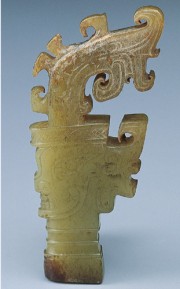
|
Jade Decorative Piece of a Crested Human Head
Resource Identifier:R009118
Description:This piece, in the shape of the profile of a human head, can be divided into three sections: neck, head and crown. The features on the face are incised in thread relief. This rare piece is small in size, but is made of fine jade and delicately carved.
Date:Late 14th-mid 11th century B.C.
Format:Length 8.5 with 3.6 cm.
Coverage:Tomb M331, Hsiao-t’un, Anyang, Honan |
| |
|
| |
|
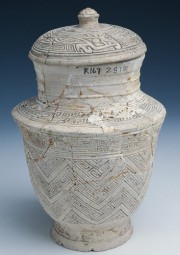
|
White Pottery Jug
Resource Identifier:R000167
Description:Excavated Shang white pottery vessels are rare. Intact pieces are even more rare and exclusively unearthed from the large and medium sized tombs of Phase I and Phase II of the Yin-hsu period. This vessel looks like a lei, but is smaller in size. It has a round lid with mushroom-shaped knob on the top. The surface of the vessel is mainly decorated with grooves and cloud-and-thunder patterns; the knob is also decorated with whorls and the lid with curled dragons. The character “五wu (five)” appears both on the inner side of the lid and on the ring foot.
Date:Late 14th-mid 11th century B.C.
Format:Height 19.0, diameter of mouth 10.6 cm.
Coverage:Tomb M331, Hsiao-t’un, Anyang, Honan |
| |
|
| |
|

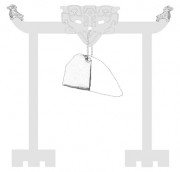
|
Stone Bird Figurine
Resource Identifier:R010556_1
Description:One of this pair of sculptured bird figurines was seriously damaged. The bird figurine appears to have a hooked beak and a high-standing comb. Its eyes are shaped like the character “臣 chen.” The feathers on its wings are carved out as curled clouds while feathers on its breast are like fish scales. Judging by the shape under the belly, they probably were decorative pieces at the two ends of the hanging bar of the frame used for hanging a chime stone.
Date:Late 14th-mid 11th century B.C.
Format:Height 8.6, length 7.9, width 4.7 cm.
Coverage:Tomb M331, Hsiao-t’un, Anyang, Honan |
| |
|
| |
|

|
Jade Dagger-axe with Bronze Tang
Resource Identifier:R000850
Description:The front section of the blade of this dagger-axe was made of jade. The rear section and the tang were made of bronze. It is decorated with animal masks and bird-heads, and inlaid with turquoise.
Date:Late 14th-mid 11th century B.C.
Format:Length 32.9, blade width 6.8 cm.
Coverage:Tomb M331, Hsiao-t’un, Anyang, Honan |
| |
|
| |
|

|
Tri-sectioned Yu Flask with a Swing Handle
Resource Identifier:R001071
Description:Two sculptured hares are depicted at the point where the handle joins the vessel body. A frog-shaped link lies on the domed lid and joins the handle to the knob of the lid. The lid, handle and link were cast separately then joined together. The vessel can be separated into three sections: the lid, upper and lower part of the vessel body. The upper part, when put upside-down, forms a ku beaker.
Date:Late 14th-mid 11th century B.C.
Format:Height 28.0, maximum diameter of belly 16.3 cm
Coverage:Sacrificial Pit M1022, Hsi -pei-kang, Anyang, Honan |
Text and images are provided by Institute of History and Philology, Academia Sinica
Digital Resources and Archived Images Application
|


























